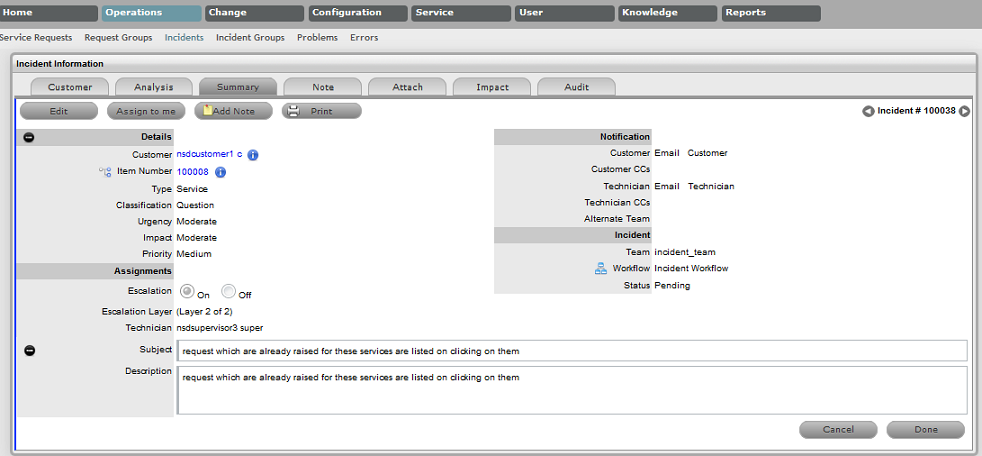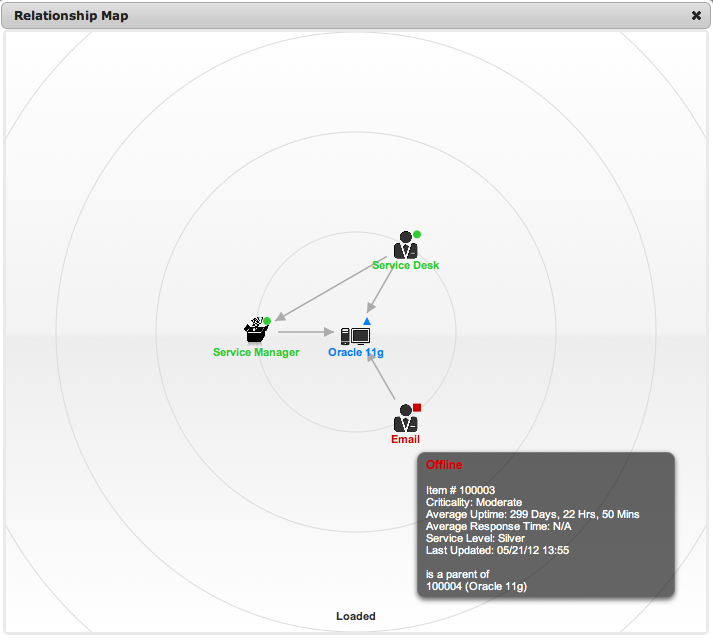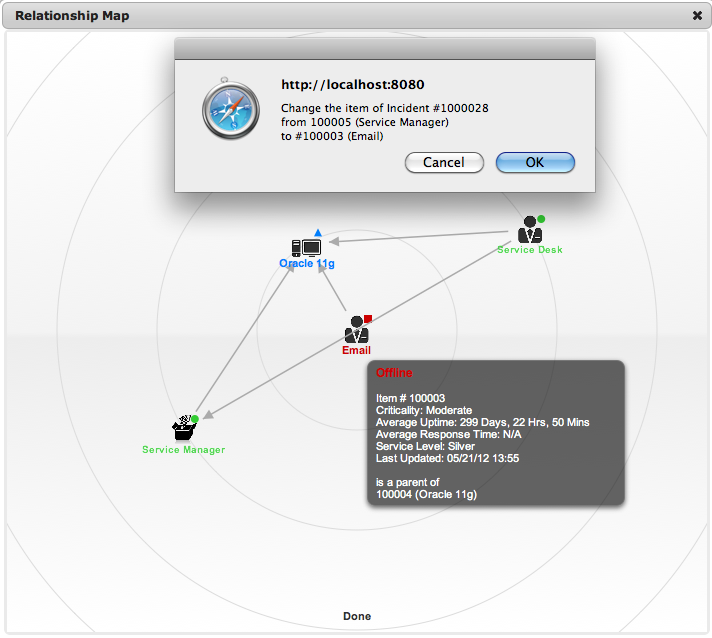Summary Tab
Summary
The Summary tab provides comprehensive details related to an Incident and gives access to the tabs required to work on the Incident. To view the details of a Customer, select the Customer name link within the Incident Information screen. The Customer and Item assigned to the Incident can be updated within the Customer tab by selecting  , when in Edit mode.
, when in Edit mode.
The Incident Information Summary tab includes the following:
|
Summary Tab |
Description |
|---|---|
|
Details |
The following details are displayed:
|
|
Assignments |
The following details are displayed:
|
|
Notification |
The following details are displayed:
|
|
Incident |
The following details are displayed:
|
|
Service Terms |
The following details are displayed:
|

NOTE:Only Technicians assigned to the Team can edit the Incident.
|
Summary Tab Buttons |
|
|---|---|
|
|
Edit opens the Incident in edit mode. This allows the Incident details to be amended, Notes to be added and time is automatically recorded against the Incident whilst in edit mode. |
|
|
Changes the default assignee of an incident to a different technician.This right is available only for technicians belonging to the same layer or team. |
|
|
Opens the Incident in edit mode and moves directly to the New Note editor. |
|
|
Duplicate creates a copy of the Incident and links the copy to the original Incident. The User can then amend the Customer or Item details, if required. |
|
|
Print opens a summary of the Incident in a Print View window. This includes a Description and all Notes added to the Incident. It is a good alternative for viewing Incident information within one window when adding a new Note. NOTE:To remove Private Notes from the output, remove the tick in the 'Show Private Notes' box. |
|
|
Allows the User to create or view reminders related to the Incident. When published it will be displayed like the normal alert icon. |
|
|
The escalation buttons allow the User to escalate the Incident to next layer within the Team, or de-escalate the Incident to the lower level, if required. |
Changing an Incident's Customer or Item
After an Incident has been created, it may be necessary to change the assigned Customer or Item. This may be the case when the Unknown Item is associated with a request, or a Service Item has been assigned to the Incident and the relevant hardware, software or network Item needs to be associated with the Incident. When the "Allow Unknown" option is disabled in the Setup>Privileges>Requests tab and a Incident that is assigned to the Unknown Item is opened in Edit mode, the User will be prompted to update the Item assigned to the Incident before the Save button action can successfully record changes to the Incident.
NOTE:This option is required when an Incident is created through Email, as the Item assigned may be the system's default Unknown Item or the Org Unit's default Item.
To change the Item:
-
Click the Incident's Edit button
-
Select the Incident's Customer tab
-
Click the Item Number

The Find Item option appears.
-
Search and select a new Item
-
Click

-
Select the Summary tab to continue working on the Incident, or click Cancel and Done to close the Incident with the newly assigned Item.
NOTE:Technicians do not have the ability to delete Incidents or Customers.
To change the Customer:
-
Click the Incident's Edit button
-
Select the Incident's Customer tab
-
Click
 next to the Customer Name
next to the Customer Name
-
Search and select a Customer
-
Click

If the Incident's Item needs to be altered as a result of the Customer change the Find Item field appears. Search and select the appropriate Item using the Find Item search.
-
Select the Summary tab, to continue working on the request
-
Click Save.
Converting an Incident to a Service Request
An Incident that has been logged against a Service Item, can be converted to a Service Request within the Analysis tab. This action results in the Service Request maintaining the same request identification number and audit trail, which records the conversion.
To convert an Incident logged against a Service Item to a Service Request:
-
Select Edit within the Analysis tab
-
Select the Convert to Service Request option.
The Incident ID # is associated with a new Service Request and the Request is assigned the Entry State of a relevant Service Request Workflow. The audit trail of the Service Request records the conversion time and date. The customer is not notified about the Process amendment.
Item Relationship Map and Assignment
Selecting  opens a pop-up window that displays a map of Items that are related to the Request Item that can be navigated by clicking on the icons within the map. To view related Item information, scroll over the relevant Item icon.
opens a pop-up window that displays a map of Items that are related to the Request Item that can be navigated by clicking on the icons within the map. To view related Item information, scroll over the relevant Item icon.

Updating the Item associated with the Request
The Item associated with the request can be updated when in the request is in Edit mode:
-
Select

-
Navigate the map to move the relevant Item icon to the central point of the map
Select the Item icon label in the Map to move it to the central node.
-
Click the icon label when it is in the middle of the map
A warning message is displayed, prompting the confirmation of the Item change.

-
Select OK and the Item association will be updated
(If the Enable Item Shadow option is enabled by the Administrator in the Setup>Privileges>Customer tab, the change of Item information will not be visible on the Customer Portal.)
-
Select
 to close the window.
to close the window.
The Item assignment change is recorded in the Audit tab.
 next to the
next to the  to view the Workflow in its entirety.
to view the Workflow in its entirety.
 - Workflow is in an SLA paused state. Triggers will not fire.
- Workflow is in an SLA paused state. Triggers will not fire.
 - Workflow is in an SLA timers on state. Triggers will fire.
- Workflow is in an SLA timers on state. Triggers will fire.
 - Workflow is in an Exit state and the SLA has been successfully maintained.
- Workflow is in an Exit state and the SLA has been successfully maintained.
 - Assigned SLA has been breached and Workflow is in an Exit state.
- Assigned SLA has been breached and Workflow is in an Exit state.







